Abstract
Switching the properties of the Ag contact groups of an electromagnetic relay with the electrodeposited Ni-W and Co-W alloy coatings was studied. It is shown that these coatings are able to stabilize the spread of contact resistance within the entire test interval and to increase the service life of Ag contact groups from 2.3 × 106 to 4.5 × 106 commutation cycles. According to our research, the service life of coated contact groups is mainly determined by a change in the surface morphology caused by the electrical erosive transfer of the contact materials and to a lesser extent by the formation of poorly conductive adsorbed hydrocarbon films.
1. Introduction
Switching devices operating on the principle of dry contact is widely employed in automatic and telecontrol machinery, the measuring technique, in sensors, etc. Contact coating is an important part of these devices. It is traditionally used to reduce the contact (transient) resistance, increase the service life and operational reliability, and ensure the possibility of the commutation of the required electric current [1]. In this regard, a number of requirements are imposed on contact coatings. For switching devices, the electrical contacts of which are subjected to an influence of ambient air, as well as for almost all types of electrical connectors, a key parameter is the corrosion stability of contact coatings [2,3].
One of the main reasons limiting the service life and maximum commutation power of contact coatings is the electrical erosion of the contacts [3,4,5,6,7]. The electrical erosion stability of them is completely determined by the coating properties and, in a large measure, influences the service life of switching devices as a whole. Corrosion and electrical erosion stabilities ensure the long-term steadiness of contact resistance. The mechanical and thermal stability of contact coatings make it possible to maintain the physical integrity and morphology of the contacting surfaces during long switching test, which also determines the service life of devices.
In switching devices of a low and medium power range, most of the used contact coatings are based on Ag and Au, their doped alloys, as well as platinum group metals (Pd, Rh, Ru) and their alloys [3,8,9,10]. Such contact coatings are not without disadvantages and, in some cases, cannot provide the necessary service life and reliability of switching devices.
The main disadvantages of Ag and Au coatings are the destruction of the contact surface due to mechanical wear, as well as the sticking of contacts due to the low hardness, wear resistance, and melting temperatures of these metals. Coatings based on Ru, Rh, and Pd [11] are the propensity for the delamination and carbonization of the contact surfaces due to catalytic reactions, resulting in the formation of polymeric carbon-containing films upon an interaction with ambient air. A general disadvantage of the above coatings is their high cost and rather complicated deposition technology, especially for ruthenium and rhodium coatings.
As an alternative to these materials, contact coatings based on the binary alloys of refractory metals (Mo and W) with iron group metals (Ni and Co) [3,12,13,14,15,16,17] are becoming increasingly common. These alloys exhibit high wear and corrosion stabilities and mechanical hardness [18,19,20,21]. Additionally, they demonstrate a very high resistance to electrical erosion. In [22], electrodeposition technology was developed and tested, allowing for the production of a Ni-W alloy with a fairly homogeneous and finely crystalline structure, that excludes the formation of defects and cracks, with a coatings thickness of more than 6 μm.
Information on the electrical properties of these coatings, in particular, on the contact electrical resistance, can be found in [3,4,23,24]. In [24], the Co-W alloy coating was employed as a technological sublayer under the main (working) Ru layer. The comparative study of the contact resistance of single-layer coatings based on Co-W, Ni-W, Co-Mo, and Ni-Mo alloys presented in [23] was shown that they are inferior to no other coatings based on the platinum group metals. At the same time, it is noted [3,4] that on the value of contact resistance and its stability during switching, the coatings based on refractory metal alloys were worse than the coatings based on the platinum group metals. These results were obtained for miniature magnetically controlled contacts, which feature a low contact pressure force within the range of tens to hundreds mN and in the presence of protective N or an Ar atmosphere.
The electrical properties of coatings based on refractory metal alloys upon a switching test with a higher contact pressing force in the range of hundreds to thousands mN under ambient air are insufficiently investigated. This is an extensive and important group of switching devices, including electromagnetic relays, pushbuttons, microswitches, etc., and their comprehensive study carried out in this work is a matter of topical interest from both practical and fundamental points of view. The novelty of our study consists of the finding out and consideration of the main mechanisms determining the grounds of the change in the contact resistance and service life of contact groups with Ni-W and Co-W electrodeposited coatings as well as without them (for uncoated Ag contact pads). The switching test was carried out in the actual operating mode at a current of 1 A and voltage of 12 V under ambient air and became significant at the level of hundreds mN contact pressing force.
2. Materials and Methods
The study on the switching properties of contact coatings based on refractory metal alloys was carried out using a serially produced electromagnetic on-off relay of the open-type RES 14 application for switching the electrical circuits of wired communication equipment. This type of relay has 8 contact groups. It allows for performing a comparative switching test of several types of coatings deposited on different contact groups (pairs) over a single test cycle. An appearance of a relay and a single contact spring with a contact pad is shown in Figure 1.
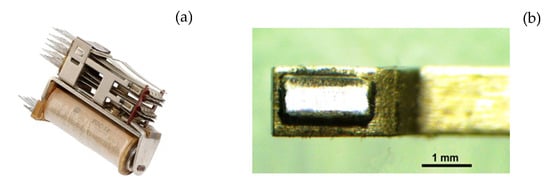
Figure 1.
A general view of a RES 14 relay (a) and a contact spring with a silver contact pad (b).
An initial value of the contact resistance Rc of uncoated silver contacts was 0.1 Ohm under a contact pressing force of about 250 mN. The coatings based on Ni-W and Co-W alloys were deposited on the silver contact pads of a near-parallelepiped shape with a dimension of 1.7 × 0.8 × 0.25 mm3. The content of refractory metal in these alloys was maintained at the level of 18–19% by choosing the deposition modes. The electrolytes’ composition and deposition mode characteristics are listed in Table 1 (for more details, see [21]).

Table 1.
The electrolytes’ composition and characteristics of deposition modes.
Microstructural images were collected using a scanning electron microscope JSM-6610LV by JEOL (Tokyo, Japan) equipped with an energy-dispersive X-ray microanalyzer INCA X-MAX by Oxford Instruments (Abingdon, UK), which allowed for determining the elemental composition of the coatings. We used a 30 keV acceleration potential in our experiments. The thickness of the coatings was determined by means of cross-section microstructural measurements on scanning electron microscopy (SEM) micrographs.
A representative SEM micrograph of a cross-section of the deposited Ni-W coating is presented in Figure 2 (a cross-section of the Co-W coating is very similar to that and is not shown here). An edge flaking is observed in this micrograph that allows for accurately estimate the thickness of the coatings. At a deposition time of 10 and 40 min for Ni-W and Co-W coatings, respectively, the thickness of these coatings was 6 ± 0.15 μm.
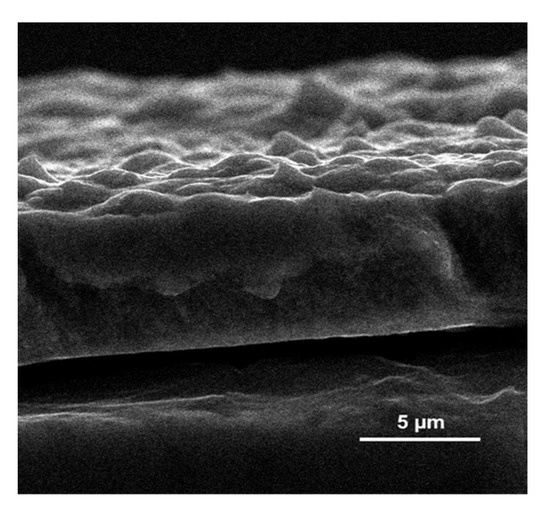
Figure 2.
Representative SEM micrograph of cross-section of the deposited Ni-W coating.
The study on the switching properties of contact coatings was carried out in the switching mode of a resistive load at a current of 1 A, an operating voltage of 12 V, and a switching frequency of 10 Hz. A switching test was performed using a specially designed measuring bench (Figure 3). It allows for fixing the change in the contact resistance of each contact group during the long switching test. Based on the measurement results, the dependences of the contact resistance on the number of switching cycles were obtained.
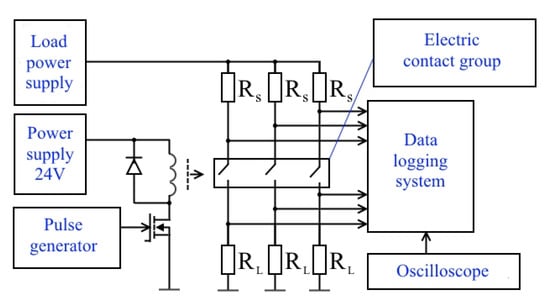
Figure 3.
Functional diagram of the measuring bench to perform switching tests.
The Rc measurement error did not exceed 1.5% and the main contribution to this error was related to the spread of the electrical resistance of the current-measuring resistors of the bench presented in Figure 3. The estimation of the average Rc and ΔRc values was carried out using mathematical data processing.
3. Results and Discussion
The degradation of the contact surfaces of the switching devices of a low and medium power range mainly results in a significant increase in the contact resistance and sticking of the contacts, which is indicated via a sharp decrease in the Rc-value in the open state (up to several tens Ohms). In our experiments, a sticking effect was not observed, which is most likely due to the high mechanical and thermal characteristics of the coatings based on refractory metals alloys. The significant elastic force of the contact springs is also facilized to that.
In Figure 4, the dependencies of the Rc-value versus the number of commutation cycles n for the uncoated Ag contact group (Figure 4a) and for those with deposited refractory metal alloy coatings (Figure 4b,c) are presented. The switching tests were ended after an increase in the contact resistance by an order of magnitude compared to its initial value.
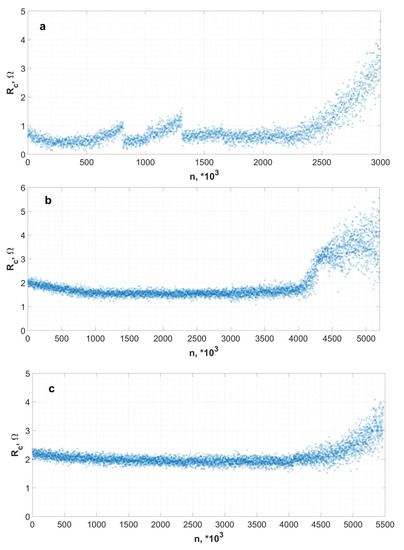
Figure 4.
Contact resistance Rc versus the number of commutation cycles n: (a) uncoated Ag contact group, (b) contact group with deposited Ni-W coating, (c) contact group with deposited Co-W coating.
The general form of Rc(n) dependencies for all the samples studied is consistent with well-known concepts (for details, see, e.g., [2] and references cited therein). In each case, these dependences exhibit an initial descending part of a different duration mainly determined by the roughness of the initial surface and mechanical characteristics of the coating material [8,24]. A sharp increase in the Rc-values observed in the final part of these dependencies indicates the beginning of the degradation of the contact surfaces.
The Rc(n) dependence for the uncoated Ag contact group (Figure 4a) exhibits several areas of an increase and then almost instantaneous fall of the contact resistance. Such a feature can be explained as follows [4,7]. Switching tests for noble metals contact group, especially Ag, carried out in ambient air are accompanied by the formation of poorly conductive adsorbed films on the contact surfaces. An increase in the total area coated by such films during switching slowly reduces the actual contact area, which in turn leads to an increase in the Rc-value. Sharp decreases of that value are associated with the destruction of adsorbed films due to a significant, about 250 mN, mechanical impact of the contact springs on the rough contact surfaces. One can note that, despite an instability of the level of contact resistance, the ratio Rc < 0.1 Ohm is observed almost over the total test interval.
For contact groups with deposited refractory metal alloy coatings, shown in Figure 4b,c, the mean level of contact resistance is more stable than in case of uncoated Ag contact. Namely, ΔRc = 0.05~0.06 Ohm is observed within the main part of the switching interval for the contact group with Ni-W alloy coatings (Figure 4b). Taking into account the shorter duration of the initial descending part of the Rc(n) dependence (ca. 8 × 105 commutation cycles) and reliance on the results obtained in [8,23,24], it can be assumed that the microhardness, ductility, and surface roughness of this coating provides the most favorable friction/contiguity conditions of the contacting surfaces, which contributes to the formation and stability of an actual (conductive) contact area.
From the data presented in Figure 4b,c, one can see that for the contact groups with deposited coatings, the mean level of the Rc-value is higher than in the case of contact with uncoated Ag. It can be explained by a significant difference in the electrical resistivity of Ag (1.6 × 10−8 Ohm ∙ m) and refractory metals alloys (ca. 7.5 × 10−8 Ohm ∙ m). In the case of Ni-W alloy coating, the Rc-value exhibits a rise on average by 0.07–0.08 Ohm, and for the Co-W alloy coating, such an increase is larger than 0.1 Ohm. Some difference in the mean level of the Rc-value for Ni-W and Co-W alloy coatings can be explained mainly by the difference in their mechanical characteristics and surface morphology, since the electrical resistivity of these materials is approximately equal.
The final part of the test interval for all the samples studied is accompanied by an in-crease in ΔRc and by a sharp rise of the Rc-value, resulting in the failure of the contact groups. From the data presented in Figure 4a, it is found that the failure of an uncoated contact group occurs after 2.3 × 106 switching cycles within a short n-range (ca. 2 × 105). As for the contact groups with deposited refractory metal alloy coatings (Figure 4b,c), their service life is significantly longer. Namely, for the Ni-W alloy, it is estimated to be more than 4 × 106 switching cycles and for the Co-W alloy, it is about 4.25 × 106. It can be noted that for the Co-W alloy, an increase in the Rc-value and coatings failure process occurred slower than for the other two samples. An experimental error of a service life estimation was within the range of 3%–5%.
For understanding the mechanisms responsible for increasing the Rc-value and the degradation of the contacting surfaces, the morphology and elemental composition of the contacting surfaces of the samples before and after the switching test were investigated. The results of the morphological research are shown in Figure 5, Figure 6 and Figure 7, and the energy-dispersive X-ray spectra (EDS) of the samples that passed the switching test are presented in Figure 8.
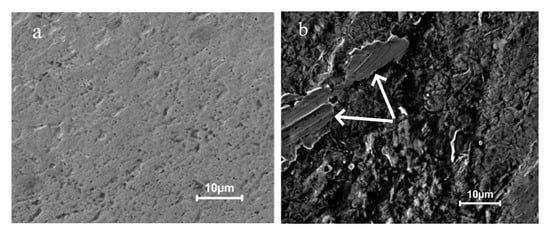
Figure 5.
SEM micrographs of the surface morphology of uncoated Ag contact group before (a) and after (b) the switching test. The regions with the shapeless depressions and protrusions formed during electrical erosive processes are marked out by arrows.

Figure 6.
SEM micrographs of surface morphology of contact group with deposited Ni-W coating before (a) and after (b) the switching tests. The regions with the shapeless depressions and protrusions formed during electrical erosive processes are marked out by arrows.

Figure 7.
SEM micrographs of surface morphology of contact group with deposited Co-W coating before (a) and after (b) the switching tests. The regions with the shapeless depressions and protrusions formed during electrical erosive processes are marked out by arrows.
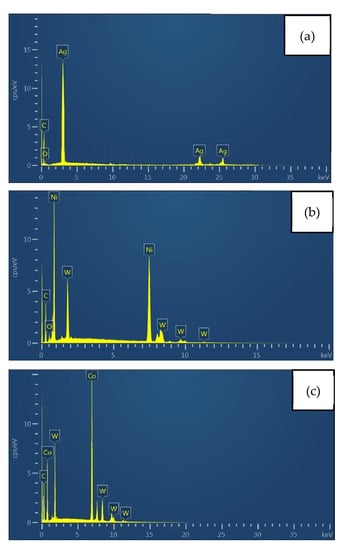
Figure 8.
EDS spectra the samples after the end of switching tests: (a) uncoated Ag contact group, (b) contact group with deposited Ni-W coating, (c) contact group with deposited Co-W coating.
Figure 5 shows the SEM micrographs of a representative surface area of the silver contact group before and after the testing. A significant change in the surface morphology, resulting in the formation of shapeless depressions and protrusions, is occurred. It can be considered as a consequence of electrical erosion, stimulating the transfer of molten materials from one contacting surface to another, as well as accompanying its deformation of the protrusions (hardening) by the opposite contacting surface. The SEM micrographs presented in Figure 6 show the less significant surface erosion of the Ni-W alloy coating after the finishing of the switching test. The surface morphology of the contact group with the Co-W alloy coating also demonstrates only a small change after the testing, which is similar the coating based on the Ni-W alloy.
The EDS spectra measured for all contact groups after the end of the switching test (Figure 8) show a pronounced carbon peak, which is not observed on the sensitivity level of our analyzer in the spectra acquired before the beginning of the test. Surface carbonization is quite an expected phenomenon since the commutation processes in ambient air are always accompanied by the formation of surface hydrocarbon films, which are decomposed into carbon under an impact of micro-arcs appearing in the course of the closing/opening of contacts. These films significantly increase the contact resistance [4,5,6,25]. From the data presented in Figure 8, one can conclude that the surface carbon content for all of the samples studied is approximately equal.
Relying on the foregoing and taking into account the significant pressing force of the relay contact springs (ca. 250 mN), which provokes the mechanical destruction of resistive films, we are inclined to assume that the main factor causing the rise in Rc and determining the service life of contact groups is a significant change in the surface morphology and associated decrease in the actual (conducting) contact area due to surface electrical erosion and mechanical wear.
Under the working conditions of the switching test carried out in our work (a current of 1 A and an operating voltage of 12 V), intense electrical erosion processes are observed, which are confirmed by the results published in [7,26]. As the main mechanisms of these processes, one can consider (i) the mechanical transfer of contact materials due to softening and/or melting stimulated by a field evaporation, (ii) the ionization of metal vapor via a field emission, which can result in the ion etching (sputtering) of contact materials, and (iii) electromigration with the metal bridges formation, where the Thomson effect and thermal asymmetry can cause the hottest point of a bridge to be biased towards one of the contacts. Analyzing the above-listed mechanisms of contact degradation, one can arrive at a conclusion that all of them, maybe, only excluded field ionization, more effectively springing into action in the case of contact materials having lower melting and/or boiling points. In that way, the deposition of contact coatings based of refractory metal alloys, which are significantly different from silver in terms of their thermal physical and mechanical characteristics, leads to an increase in the erosion and mechanical wear resistances of the contact groups studied in this work.
4. Conclusions
In the present study, the switching test of a commercially produced electromagnetic two-position relay of the open-type RES 14 with contact groups with electrodeposited coatings based on Ni-W and Co-W alloys in the mode of switching a resistive load at a current of 1 A and an operating voltage of 12 V was carried out.
The main experimental results of our study can be summarized as follows.
- The electrodeposition of contact coatings based on refractory metals alloys allows for an increase in the service life of Ag contact groups from 2.3 × 106 to 4 × 106 commutation cycles for the Ni-W alloy and to 4.25 × 106 ones for the Co-W alloy. At the same time, an increase in the mean Rc-value on 0.08–0.11 Ohm within the whole test interval was observed.
- Better results were obtained for the Ni-W coating. This coating provided a mean value Rc = 0.15–0.16 Ohm together with the minimal spread ΔRc = 0.05~0.06 Ohm.
- The service life of the Ag contact groups with electrodeposited Ni-W and Co-W coatings is mainly determined by a change in the surface morphology caused by the electrical erosive transfer of the contact materials and to a lesser extent by the formation of poorly conductive adsorbed hydrocarbon films.
Author Contributions
Conceptualization, G.P.G.; validation, D.V.S.; investigation, G.P.G., M.S.T. and E.V.S.; writing-draft preparation, G.P.G.; editing-final version preparation, A.T. All authors have read and agreed to the published version of the manuscript.
Funding
This work was supported by the Ministry of Education and Science of the Russian Federation in the frame of the state assignment FSSN-2020-0003.
Institutional Review Board Statement
Not applicable.
Informed Consent Statement
Not applicable.
Data Availability Statement
Data sharing is not applicable to this article.
Acknowledgments
The Regional Center for Probe Microscopy for Collective Use of the Utkin Ryazan State Radio Engineering University (Ryazan, Russian Federation) and personally Nikolay B. Rubin for the SEM measurements are highly appreciated.
Conflicts of Interest
The authors declare no conflict of interest.
References
- Karabanov, S.M.; Maizels, R.M.; Shoffa, V.N. Reed Switches and Equipment on Their Basis; Monograph, Publishing House “Intelekt”: Dolgoprudny, Russia, 2011. (In Russian) [Google Scholar]
- Braunovich, M.; Konchits, V.V.; Myshkin, N.K. Electrical Contacts; CRC Press Taylor & Francis Group: Boca Raton, FL, USA, 2013. [Google Scholar]
- Shishkina, L.; Lokshtanova, O.; Karabanov, S. Electroplated coatings for magnetically operated contacts (Reed Switches). Coatings 2012, 2, 1–7. [Google Scholar] [CrossRef]
- Peschot, A.; Poulain, C.; Souchon, F.; Charvet, P.-L.; Bonifaci, N.; Lesaint, O. Contact degradation due to material transfer in MEM switches. Microelectron. Reliab. 2012, 52, 2261–2266. [Google Scholar] [CrossRef]
- Yang, Z.; Hoffmann, S.; Lichtenwalner, D.J.; Krim, J.; Kingon, A.I. Resolution of the transfer direction of field-evaporated gold atoms for nanofabrication and microelectromechanical system applications. Appl. Phys. Lett. 2011, 98, 044102. [Google Scholar] [CrossRef]
- Vincent, M.; Rowe, S.W.; Poulain, C.; Mariolle, D.; Chiesi, L.; Houze, F.; Delamare, J. Field emission and material transfer in microswitches electrical contacts. Appl. Phys. Lett. 2010, 97, 263503. [Google Scholar] [CrossRef]
- Yang, Z. Contact reliability in ohmic microswitches. Mater. Technol. 2011, 26, 184–190. [Google Scholar] [CrossRef]
- Karabanov, S.M.; Verlov, N.A.; Suvorov, D.V.; Gololobov, G.P.; Slivkin, E.V. Properties of contact coatings based on ruthenium nanofilms for MEMS switches. Technic. Phys. Lett. 2015, 41, 691–693. [Google Scholar] [CrossRef]
- Shishkina, L.; Lokshtanova, O.G. Electroplated coatings for reed switches. Bull. SPbSTI 2011, 11, 122–125. (In Russian) [Google Scholar]
- Shishkina, L.; Karabanov, S.M.; Lokshtanova, O.G. Experience of development and application of the electroplated coatings used in the industrial production of magnetically operated contacts (Reed Switches). Electropl. Surf. Treat. 2011, 2, 20–26. (In Russian) [Google Scholar]
- Comparini, A.; Del Pace, I.; Giurlani, W.; Emanuele, R.; Verrucchi, M.; Bonechi, M.; Innocenti, M. Electroplating on Al6082 aluminium: A new green and sustainable approach. Coatings 2023, 13, 13. [Google Scholar] [CrossRef]
- Bodaghi, A.; Hosseini, J. Corrosion behavior of electrodeposited cobalt-tungsten alloy coatings in NaCl aqueous solution. Int. J. Electrochem. Sci. 2012, 7, 2584–2595. [Google Scholar] [CrossRef]
- Ma, L.; Xi, X.; Nie, Z.; Dong, T.; Mao, Y. Electrodeposition and characterization of Co-W alloy from regenerated tungsten salt. Int. J. Electrochem. Sci. 2017, 12, 1034–1051. [Google Scholar] [CrossRef]
- Allahyarzadeh, M.H.; Aliofkhazraei, M.; Rezvanian, A.R.; Torabinejad, V.; Sabour Rouhaghdam, A.R. Ni–W electrodeposited coatings: Characterization, properties and applications. Surf. Coat. Technol. 2016, 307, 978–1010. [Google Scholar] [CrossRef]
- Lee, H.B. Synergy between corrosion and wear of electrodeposited Ni-W coating. Tribol. Lett. 2013, 50, 407–419. [Google Scholar] [CrossRef]
- Udompanit, N.; Wangyao, P.; Henpraserttae, S.; Boonyongmaneerat, Y. Wear response of composition-modulated multilayer Ni-W coatings. Adv. Mater. Res. 2014, 1025–1026, 302–309. [Google Scholar] [CrossRef]
- Mościcki, T.; Psiuk, R.; Radziejewska, J.; Wiśniewska, M.; Garbiec, D. Properties of spark plasma sintered compacts and magnetron sputtered coatings made from Cr, Mo, Re and Zr alloyed tungsten diboride. Coatings 2021, 11, 1378. [Google Scholar] [CrossRef]
- Tsyntsarua, N.; Cesiulis, H.; Pellicer, E.; Celis, J.-P.; Sort, J. Structural, magnetic, and mechanical properties of electrodeposited cobalt-tungsten alloys: Intrinsic and extrinsic interdependencies. Electrochim. Acta 2013, 104, 94–103. [Google Scholar] [CrossRef]
- Eliaz, N.; Sridhar, T.M.; Gileadi, E. Synthesis and characterization of nickel tungsten alloys by electrodeposition. Electrochim. Acta 2005, 50, 2893–2904. [Google Scholar] [CrossRef]
- Gomez, E.; Pellicer, E.; Alcobe, X.; Valles, E. Properties of Co-Mo coatings obtained by electrodeposition at pH 6.6. J. Sol. St. Electrochem. 2004, 8, 497–504. [Google Scholar] [CrossRef]
- Gololobov, G.P.; Suvorov, D.V.; Serpova, M.A.; Tarabrin, D.Y.; Tolstoguzov, A. Study on the surface morphology and corrosion rates of electroplated coatings based on binary alloys of refractory metals after accelerated acid tests. Trans. Inst. Met. Finish. 2021, 99, 102–108. [Google Scholar] [CrossRef]
- Suvorov, D.V.; Gololobov, G.P.; Tarabrin, D.Y.; Slivkin, E.V.; Karabanov, S.M.; Tolstoguzov, A.B. Electrochemical deposition of Ni-W crack-free coatings. Coatings 2018, 8, 233. [Google Scholar] [CrossRef]
- Gololobov, G.P.; Suvorov, D.V.; Serpova, M.A.; Arefiev, A.S. The study of contact electrical resistance of coatings on the basis of refractory metal alloys Co-W., Co-Mo, Ni-W., Ni-Mo. J. Phys. Conf. Ser. 2020, 889, 012017. [Google Scholar] [CrossRef]
- Gololobov, G.P.; Suvorov, D.V.; Karabanov, S.M.; Slivkin, E.V.; Tolstoguzov, A. An effect of Co-W barrier sublayer on the functional characteristics of Au-Ru contact coatings. Coatings 2022, 12, 161. [Google Scholar] [CrossRef]
- Czaplewski, D.A.; Nordquist, C.D.; Dyck, C.W.; Patrizi, G.A.; Kraus, G.M.; Cowan, W.D. Lifetime limitations of ohmic, contacting RF MEMS switches with Au, Pt and Ir contact materials due to accumulation of ‘friction polymer’ on the contacts. J. Micromech. Microeng. 2012, 22, 10502305. [Google Scholar] [CrossRef]
- Basu, A.; Hennessy, R.P.; Adams, G.G.; McGruer, N.E. Hot switching damage mechanisms in MEMS contacts-Evidence and understanding. J. Micromech. Microeng. 2014, 24, 105004. [Google Scholar] [CrossRef]
Disclaimer/Publisher’s Note: The statements, opinions and data contained in all publications are solely those of the individual author(s) and contributor(s) and not of MDPI and/or the editor(s). MDPI and/or the editor(s) disclaim responsibility for any injury to people or property resulting from any ideas, methods, instructions or products referred to in the content. |
© 2023 by the authors. Licensee MDPI, Basel, Switzerland. This article is an open access article distributed under the terms and conditions of the Creative Commons Attribution (CC BY) license (https://creativecommons.org/licenses/by/4.0/).